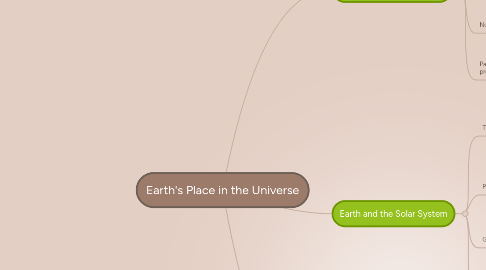
1. The Universe and It's Stars
1.1. The Milky Way Galaxy
1.1.1. Includes the sun and many other stars
1.2. The Big Bang
1.2.1. 13.7 Billion Years ago
1.2.2. Created galaxies that fill the universe
1.3. Observable Matter
1.3.1. Hydrogen
1.3.2. Helium
1.4. Nuclear Fusion
1.4.1. Produces atomic nuclei lighter than iron
1.4.2. Process releases energy seen as starlight
1.4.3. Heavier elements produced in supernovas
1.5. Patterns of motion can be observed and predicted
1.5.1. Great example for use of models
2. Earth and the Solar System
2.1. The Solar System
2.1.1. Formed from dust and gas
2.1.2. Held in orbit by gravitational pull
2.1.3. Consists of sun, planets and their moons
2.2. Predictable patterns of movement
2.2.1. Gravitational Forces and Conservational Laws
2.2.2. Kepler's three empirical laws
2.2.2.1. based on Newton's theory of gravity
2.2.3. Sunrise and Sunset predictable
2.3. Gravity
2.3.1. Holds planets in orbit
2.3.2. Planet's positions relative to lunar and solar eclipses
2.4. Earth's Orbit
2.4.1. Circular
2.4.2. Spins on tilted axis
2.4.2.1. result in seasons
2.4.2.2. Seasonal variations intensity greatest at the poles
3. The History of Planet Earth
3.1. Fossils
3.1.1. radioactive elements in rocks help to find geological age
3.1.2. Youngest rock at the top, oldest at bottom
3.1.3. Some as old at 4 billion years
3.1.4. Records show massive extinction and volcano activity
